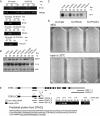Transcriptional networks and cellular senescence in human mammary fibroblasts
- PMID: 15574883
- PMCID: PMC545924
- DOI: 10.1091/mbc.e04-05-0392
Transcriptional networks and cellular senescence in human mammary fibroblasts
Abstract
Senescence, the molecular program that limits the finite proliferative potential of a cell, acts as an important barrier to protect the body from cancer. Techniques for measuring transcriptome changes and for modulating their expression suggest that it may be possible to dissect the transcriptional networks underlying complex cellular processes. HMF3A cells are conditionally immortalized human mammary fibroblasts that can be induced to undergo coordinated senescence. Here, we used these cells in conjunction with microarrays, RNA interference, and in silico promoter analysis to promote the dissection of the transcriptional networks responsible for regulating cellular senescence. We first identified changes in the transcriptome when HMF3A cells undergo senescence and then compared them with those observed upon replicative senescence in primary human mammary fibroblasts. In addition to DUSP1 and known p53 and E2F targets, a number of genes such as PHLDA1, NR4A3, and a novel splice variant of STAC were implicated in senescence. Their role in senescence was then analyzed by RNA silencing followed by microarray analysis. In silico promoter analysis of all differential genes predicted that nuclear factor-kappaB and C/EBP transcription factors are activated upon senescence, and we confirmed this by electrophoretic mobility shift assay. The results suggest a putative signaling network for cellular senescence.
Figures



Similar articles
-
58-kDa microspherule protein (MSP58) is novel Brahma-related gene 1 (BRG1)-associated protein that modulates p53/p21 senescence pathway.J Biol Chem. 2012 Jun 29;287(27):22533-48. doi: 10.1074/jbc.M111.335331. Epub 2012 May 4. J Biol Chem. 2012. PMID: 22563078 Free PMC article.
-
p53 Transactivates the phosphatase MKP1 through both intronic and exonic p53 responsive elements.Cancer Biol Ther. 2004 Dec;3(12):1277-82. doi: 10.4161/cbt.3.12.1370. Epub 2004 Dec 15. Cancer Biol Ther. 2004. PMID: 15611668
-
The noncatalytic amino terminus of mitogen-activated protein kinase phosphatase 1 directs nuclear targeting and serum response element transcriptional regulation.Mol Cell Biol. 2005 Jun;25(11):4792-803. doi: 10.1128/MCB.25.11.4792-4803.2005. Mol Cell Biol. 2005. PMID: 15899879 Free PMC article.
-
B-Myb, cancer, senescence, and microRNAs.Cancer Res. 2011 Aug 15;71(16):5370-3. doi: 10.1158/0008-5472.CAN-11-1044. Epub 2011 Aug 9. Cancer Res. 2011. PMID: 21828240 Free PMC article. Review.
-
Cell senescence as both a dynamic and a static phenotype.Methods Mol Biol. 2013;965:1-13. doi: 10.1007/978-1-62703-239-1_1. Methods Mol Biol. 2013. PMID: 23296648 Review.
Cited by
-
Control of the senescence-associated secretory phenotype by NF-κB promotes senescence and enhances chemosensitivity.Genes Dev. 2011 Oct 15;25(20):2125-36. doi: 10.1101/gad.17276711. Epub 2011 Oct 6. Genes Dev. 2011. PMID: 21979375 Free PMC article.
-
The Epigenetic Reader, Bromodomain Containing 2, Mediates Cholangiocyte Senescence via Interaction With ETS Proto-Oncogene 1.Gastroenterology. 2023 Jul;165(1):228-243.e2. doi: 10.1053/j.gastro.2023.03.235. Epub 2023 Apr 12. Gastroenterology. 2023. PMID: 37059338 Free PMC article.
-
Senescence and NFκB: A trojan horse in tumors?Oncoimmunology. 2012 Dec 1;1(9):1594-1597. doi: 10.4161/onci.22525. Oncoimmunology. 2012. PMID: 23264905 Free PMC article.
-
TNFRSF11A and TNFSF11 are associated with age at menarche and natural menopause in white women.Menopause. 2010 Sep-Oct;17(5):1048-54. doi: 10.1097/gme.0b013e3181d5d523. Menopause. 2010. PMID: 20531232 Free PMC article.
-
Transcriptomic Analysis of Human Podocytes In Vitro: Effects of Differentiation and APOL1 Genotype.Kidney Int Rep. 2022 Oct 17;8(1):164-178. doi: 10.1016/j.ekir.2022.10.011. eCollection 2023 Jan. Kidney Int Rep. 2022. PMID: 36644347 Free PMC article.
References
-
- Ali, S. H., and DeCaprio, J. A. (2001). Cellular transformation by SV40 large T antigen: interaction with host proteins. Semin. Cancer Biol. 11, 15-23. - PubMed
-
- Benvenuti, S., Cramer, R., Quinn, C. C., Bruce, J., Zvelebil, M., Corless, S., Bond, J., Yang, A., Hockfield, S., Burlingame, A. L., Waterfield, M. D., and Jat, P. S. (2002). Differential proteome analysis of replicative senescence in rat embryo fibroblasts. Mol. Cell Proteomics 1, 280-292. - PubMed
-
- Bodnar, A. G., Ouellette, M., Frolkis, M., Holt, S. E., Chiu, C. P., Morin, G. B., Harley, C. B., Shay, J. W., Lichtsteiner, S., and Wright, W. E. (1998). Extension of life-span by introduction of telomerase into normal human cells. Science 279, 349-352. - PubMed
Publication types
MeSH terms
Substances
Grants and funding
LinkOut - more resources
Full Text Sources
Other Literature Sources
Molecular Biology Databases
Research Materials
Miscellaneous

